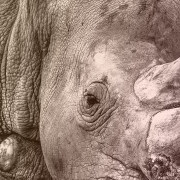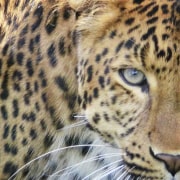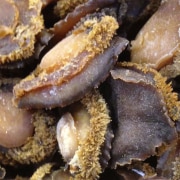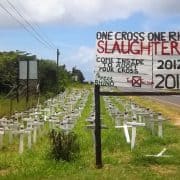|
Getting your Trinity Audio player ready...
|
Wildlife poaching is still a problem that affected countries such as South Africa can’t seem to get to grips with. A new report, released in November 2016 by the Environmental Investigation Agency (EIA), details the role that corruption plays in the perpetuation of the atrocious trade – corruption that emanates not only from countries that demand the goods, but from countries where the goods are found, such as South Africa.
The report, titled Time for Action: End the criminality and corruption fuelling wildlife crime, shows that although there are some positive examples of progress, the global criminal justice response to wildlife crime has largely failed to turn the tide against the organised criminal syndicates involved. “Words have not become action quickly enough,” EIA notes. This type of crime therefore continues to be a high profit, low risk enterprise.
The Declaration of the London Conference on the Illegal Wildlife Trade (the London Declaration) was adopted in February 2014 by 46 countries and 11 international organisations. The declaration called for an end to wildlife trafficking and demand for wildlife products, the increasing enforcement of laws against poaching, and the sustainable use of wildlife. Since this time, however, records collated by EIA show there has been no respite in the scale of the trade in a number of key species.
South Africa was not represented at a political level at the London conference because of the opening of Parliament. However, the Department of Water and Environmental Affairs did welcome some – but not all – of the provisions contained in the London Declaration.
The EIA report also profiles 15 key countries, some of which play an important role in the illegal wildlife trade, and some of which have adopted the London Declaration. The former include India, South Africa and Thailand while the latter countries include Botswana, China, Kenya, Laos, Malawi, Mozambique, Nepal, Tanzania, Uganda, the UK, the US and Vietnam. All 15 countries are parties to the UN Convention against Transnational Organized Crime (UNTOC).
The report highlights these 15 countries (referred to as the IWT countries) in terms of their roles in the wildlife trade, positive actions they have taken, and challenges that they still face.
Lucrative profits from unethical trade
Illegal wildlife trade is a small but significant part of the growing global exploitation of natural resources, and is valued at anywhere from $7-billion to $23-billion per year. Partly fuelled by demand from China and South-East Asia, the trade is enabled by criminality and corruption.
Efforts to tackle the problem have been inconsistent, and despite the judicial sectors in all 15 countries able to pursue more severe sentencing under applicable legislation, cases in which deterrent penalties are imposed are uncommon. Many criminals are given fines which pale in comparison to the profits they have earned.
Furthermore, possession of illegal wildlife products is not a crime in countries such as China and Uganda, but it should be, says EIA.
The corrupt get away with their dirty deeds because the commitment to tackling them remains largely on paper, says EIA – even though governments committed to a zero tolerance approach to corruption under the London Declaration. The prevalence of corruption causes a “severe impediment” in tackling wildlife trafficking – of the 15 IWT countries, 12 scored less than 50 on Transparency International’s 2016 Corruption Perceptions Index, indicating a serious corruption problem. Only Botswana, the US and the UK scored over 50.
South Africa, Mozambique, Laos and Vietnam are additionally problematic in that anti-corruption inaction has resulted in an international criminal network setting up shop within their borders – one that “rivals drugs, arms and human trafficking in both scale and profitability”, writes Adam Cruise. This has happened despite public announcements and signed memoranda of understanding.
The four countries are doing little to combat the criminal networks involved in the flood of wildlife products that pours out of Africa, and in fact they have evolved into something of a hub for the international criminal wildlife trade network, Cruise adds.
SA not doing enough
The EIA profile on South Africa shows that it has made some gains in investing in enforcement and ensuring effective legal deterrents.
For instance, the Financial Intelligence Centre has been involved in investigations into wildlife crime, including the tracing of funds to a key rhino horn trader and subsequent seizure of around R190 000. And an increase in the number of convictions and stronger sentences has been noted in recent years, including through the use of ancillary legislation. Convicted wildlife poachers have received jail sentences in South Africa of up to seven decades. Earlier in January 2017 a rhino poacher was sentenced to an effective 33 years in jail in Mpumalanga.
South Africa has not fared so well in eradicating demand for illegal wildlife products, where there has been little to no progress in implementing London Declaration commitments such as prohibiting trade in elephant ivory and parts or products of Asian big cats, or destroying stockpiles of ivory and other items.
The country is both a source and a traffic point for the ivory trade, and a source for rhino horn and tiger bones and skin. The growing trade in South Africa in tigers and tiger skins, as well as its tragic lion bone industry, is of concern to EIA.
Corruption adds to the problem
Corruption in South Africa was specifically noted as an obstacle to effective wildlife crime enforcement, and the implication of officials in poaching-related crimes is worrying. For instance, 11 policemen were arrested during 2015 in connection with rhino horn trade, according to a report titled Tipping Point which was published by the Global Initiative in 2016. While various anti-corruption bodies exist, this report notes, the police have not had an effective anti-corruption strategy since the Anti-Corruption Unit was shut down by Jackie Selebi in 2001, and the Department of Environmental Affairs is also lacking a specific anti-corruption programme.
In 2014, 39 rhino horns and 75 pieces of horn worth around R55-million were stolen from a safe in the Mpumalanga Tourism and Parks Board office. The Hawks’ investigation into the matter faltered when the investigator was himself charged with a poaching-related crime in late 2016.
The Tipping Point report also states that corruption is a serious problem in the Kruger National Park, where two rangers were arrested in relation to rhino poaching in June 2016, and in certain provincial conservation offices. Here, officials have been implicated in taking kickbacks, selling hunting permits under the counter and turning a blind eye to abuses in the hunting industry, among other allegations.
South Africa’s state security minister David Mahlobo has also been implicated in rhino poaching. The Hawks launched an inquiry into the matter after Al Jazeera’s investigative unit reported in November that it had uncovered evidence of high-level political connections to the illegal trade into rhino parts, naming Mahlobo as one of those allegedly involved, as well as Chinese nationals.
The SABC reported recently that the Hawks were to consult with the National Prosecuting Authority (NPA) regarding the Mahlobo inquiry, following the reported disappearance of one of the Chinese implicated in the matter. This has put the brakes on the inquiry, with the Hawks now saying they are not investigating the minister.
Africa’s elephant population is in serious decline, because of corruption. EIA’s report on the ivory trade in Tanzania, Vanishing Point, reveals that the country has lost two-thirds of its elephant population since 2006. The EIA Time for Action report reveals that Mozambique has lost half of its elephants since 2005 – here 539 poachers were arrested between 2012 and 2014, but only 17 fines resulted and no prison sentences.
“Such extreme levels of poaching can only persist in an environment that allows organised criminal syndicates to operate with impunity due to poor governance and systemic corruption,” the report notes.
Corruption is a key enabler in what is a long and complex ivory trafficking chain requiring the involvement of rangers, police and revenue officers responsible for checking the contents of shipping containers, while those higher up on the political ladder protect the criminals beneath them, because they profit too.
What can be done?
EIA says that forging alliances with local communities and the private sector is of critical importance.
There are many existing mechanisms that can be used to fight corruption in wildlife and forest crime. All 15 IWT countries have (in place) some basic infrastructure and capacity to investigate, prosecute and impose meaningful penalties on those involved, but failure to tackle the criminality, corruption and weak governance associated with wildlife crime has accelerated the decline of many wildlife species.
With the immense financial sums found in this illicit trade, greater emphasis should be placed on recognising these crimes as predicate offences utilising existing money-laundering mechanisms and applying intelligence-led investigation techniques to follow the money.
Countries should make more use of non-wildlife specific legislation to bring criminals to book. However, says EIA, only a few of the IWT countries have made any progress in adopting guidelines for both charging and sentencing under alternative legislation. Countries would do well to follow the example of India’s Wildlife Crime Control Bureau, which In March 2015 issued an advisory providing guidance on the use of the Prevention of Money Laundering Act for wildlife offences.
Ensuring that effective legislation is on place and that it is enforced competently, as well as taking steps to eradicate the market for illegal animal parts, is the only way to make any sort of meaningful progress. Countries must also establish a monitoring and evaluation framework, so that progress can be measured.








